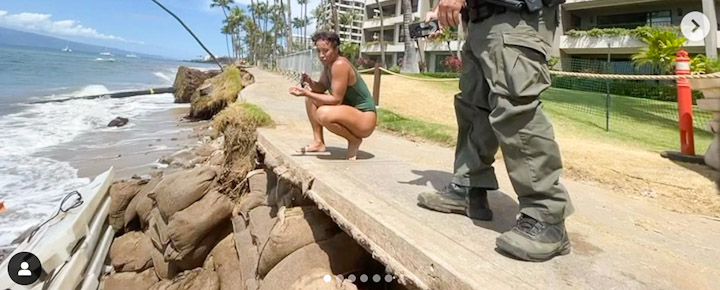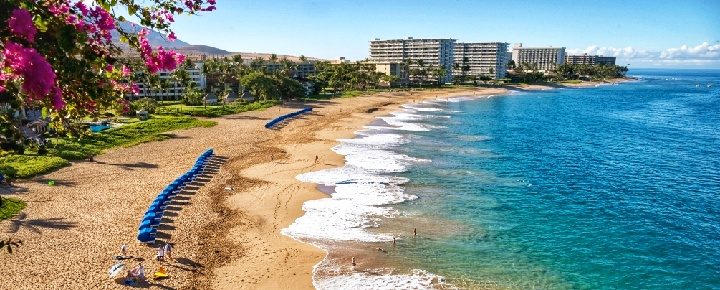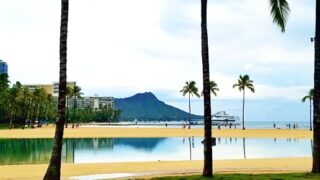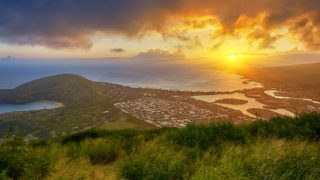The only U.S. beach that ranked #1 recently on the world’s best list will apparently not be restored. At least so went Friday’s decision by the Hawaii Department of Land and Natural Resources Board. The plan had been to bring enough sand from off-shore onto Kaanapali Beach to hopefully provide at least 15 more years before significant erosion would again become apparent.
The decision comes after four decades of continuous erosion plus a recent high tide event on Maui that also caused a collapse in the famed walkway. The area of concern is near the Kaanapali Alii Resort, the Hyatt Regency Maui, Sheraton Maui Resort, Kaanapali Beach Hotel, restaurants, shopping, and the legendary Black Rock.
As recently as late last year, it appeared that DLNR was on board the long-planned Kaanapali Beach restoration project which might have provided the extra time needed for these businesses to continue before more extensive changes are necessitated in the future.
We’ve known for decades that these buildings should not be there.
Kaanapali now finds itself in a situation where many high-end properties have been built on beaches that are fast eroding, with no planned or likely possible solution. There isn’t an easy solution that forestalls the inevitable.
It was clear to many from the outset to think that the remediation could be both successful and not harmful was a fantasy. Studies have indicated that such “nourishment” projects don’t provide long term benefit and have a detrimental impact on wildlife.
The only U.S. beach recently ranked among the best beaches in the world.
Kaanapali Beach was just honored as being among the best beaches in the world. It was the only beach in the United States to be included. In addition, Kaanapali was honored as 1st on the list of top 25 beaches in the United States. That list also included beaches in Hawaii. These were a part of TripAdvisor’s 2023 Travelers’ Choice Awards.
Despite the erosion, Kaanapali remains a spectacular three-mile-long stretch of iconic white sand. Kaanapali also has a venerable place in Maui’s history.
Why the state nixed the $10M Kaanapali Beach Restoration project.


There has been growing concern about the large-scale sand mining that would have been required to dredge adequate sand for the shoreline’s restoration and beach build-up. In addition, ongoing concern has been expressed about the potential reef and wildlife damage, among other problems.
The state is also sensitive to the fact that this project would have benefitted high-end condos, hotels, and businesses along the beach. It is proposed instead that those properties begin planning a retreat from the eroding shoreline.
The DLNR Board has shown a new determination in dealing with climate change and rising sea levels. The board is opting to move its focus from protecting private properties to one protecting public beaches. This represents a significant shift at state DLNR. DLNR previously said, “Right now is literally the time when it’s most affordable and easiest for us to get engaged in managed retreat. Figuring that out is a problem, but we’re not the only community in the world that has this issue. Literally, every coastal community does.”
About Kaanapali Resort.
First developed over 60 years ago, before the beach erosion was apparent, it has grown to encompass nearly 5K guest accommodations with 1/2 million annual visitors. The resort members have looked at the beach erosion problem for over 15 years. Almost a decade ago, it entered into a preliminary agreement with the state to help fund the restoration project.
The $10M cost was to have been paid half by the state and half by the entity representing the hotels, condos, stores, and golf courses. The state had already allocated the funds for the project before this about-face.
While the matter may not be closed entirely, the new direction of the state DLNR is clear. Other processes will still need to take place before a final decision. But ultimately, the board and extensive public testimony indicate a lack of future support for the restoration project. Since additional permitting is required before any work can begin, it isn’t clear whether those permits will or won’t be forthcoming.
Get Breaking Hawaii Travel News






Well, looks like Maui may be looking at shooting itself in the foot on the beach replenishment project. I seems that DLNR is taking an ‘environmental’ versus ‘business’ approach to this project, as HI often likes to bill itself. But, if they let the beaches go and proudly stand on the rocks and say, this is nature doing what nature does, why should the tourists who occupy the hotels, etc., continue to come to Maui? To visit the rocks? For the ‘food’? To see the ‘needle’ or drive to Hana? Do they really think ‘culture’ will drive tourism???
So, hotels cutback staffing, or close out right due to non-profitability. Locals cry, “What about our jobs!?”
The ‘love/hate’ HI has with tourism isn’t going to solve itself by letting the beaches wash away, and it will probably exaserbate the wage/job and housing affordability issues. So what is the end result of DLNR’s stance, and will the people of HI benefit from the disappearing beaches?
Do what’s best for nature.
Hello, we have already planned a stay at the Hyatt on Kanapali Beach and this worries me. We r going in March and hoping the beach will still be intact. Please let me know if we should go elsewhere.
I agree that the Kaanapali walkway should not be refurbished. Maui, and all of Hawaii, should be preserved as it stands now, without further building, which could harm it’s natural beauty and wildlife. I am a visitor to Maui often and try to leave a minimal footprint while there.
I have also visited the Outer Banks of No.Carolina. The islands there have shut down some beaches for preservation since I first started visiting because of too much human traffic. I hope Maui and all of Hawaii can do the same soon.
What total horse pooie. For the same entities the originally approved permits for the construction of the properties to claim they shouldn’t have been built is totally lame and a complete cop out. Work something out.
How might this affect our October trip to Ka’anapali Beach Hotel?
It won’t. Just come and enjoy yourself 🌞
Beth
Linda B … unless there is a big change that has happened, it won’t. The worst of if is at the Alii (sp).
Thanks for the article, BOH. We’ve been in West Maui for several months and walk the Kaanapali Beach path nearly every day. Over the years, we have seen parts of the beach come and go, and come back again. It seems to be cyclical.
The number of jobs and the billions of tax dollars brought in at Kaanapali is staggering. It would be interesting to see what all the people of Hawaii think of losing this source of income, not just people who make comments on BOH and other forums.
The shoreline and beaches from Kaanapali to Honokowai were pristine before all the development. This land was our ‘Ohana and my father would spear fish here with his tutukane while tutuwahine would wait for them to return. The over-developed construction contributed to the erosion and there is always a price to pay….
Curtis those are wonderful memories. With the establishment of Resorts and Hotels being popularized for their close proximity to the beaches and ocean have had a “limited effect” but not to say none. What is effecting the erosion most is the Wave Motion of the Ocean coupled with Storms of medium to High Intensity such as Hurricanes. This has been identified by Native Hawaiians for Hundreds of Years. Unfortunately some of the Storms have Intensified causing more erosion than we have seen in the previous 80 years. Transient use of the water and beaches doesn’t cause what is being seen, neither does a Resort that sits 100 yards from the beach. It’s a Fallacy being perpetrated for nefarious reasons.
While I’m not a fan of all the hotels that have been bilt on the Kaannapali beach area, and continue to be permitted to be bilt, they are an easy target for those who want to return HI, and the beaches in particular, to ‘the good ol’ days’. Hotels don’t cause beach erosion, nature/weather does. The hotels are a ‘blight’, both visual and environmental, but it’s not likely they are going to get knocked down to return the area to some semblance of ‘the good ol’ days’ people like to wistfully talk about.
Any decision made, someone will be paying for something… either to nourish the beach or compensate these businesses giving up oceanfront real-estate. Unfortunately, it’s the locals who bear most of it. This is their home, most of us are just visiting.
In NC, specifically the OBX, beach nourishment is absolutely necessary every so many years or else those barrier islands wouldnt be there… or at least the homes and businesses wouldn’t. I’ve often wondered how the machines the use to complete these projects affect sea life.
I think you are correct that there has been a change in attitude about such projects at DLNR, but I got the idea that the DLNR’s position was more that it wasn’t an appropriate use of public money, rather than it couldn’t be done. I wonder if they would be more agreeable if KOA funded the whole thing itself.
Whether sand nourishment is the best solution is a question for the EIS to resolve. I don’t have the source, but a Sea Grant researcher told me that bioabundance showed increases, including coral and tako, at Iroquois Point after that project was completed. Results undoubtedly vary by site, as each is different. Better than letting the buildings and sidewalks fall into the sea.
It’s True that Reclaiming the Beach Sand does have Beneficial Effects on The Reefs and Marine Life, research has proven this. Those neighsayors either are uneducated to the facts or have some other agenda. The Beaches should be resanded for viability knowing that it is a Win/Win in Many Ways. Since when has Hawaii been known to Skimp and Shy Away from spending Money? Is it because they only have to pay for Half of the project? If the DNR had to pay 100% would it be no problem? Something isn’t right here.